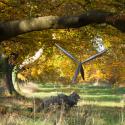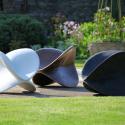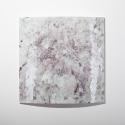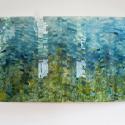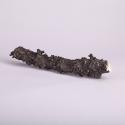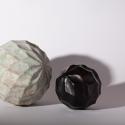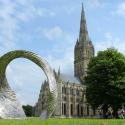Discipline
Abstract
Architectural / Monumental / Relief
Installation
Kinetic/Mobile
Material
Brick/Concrete/Plaster
Glass
Steel
Wood
Region
South West
Biography
Rebecca Newnham is a sculptor with a special interest in glass. Sculpture and curved wall panels employ enamelled glass as a faceted skin which champions the characteristics of plants, experience of place, and our understanding of organic systems. Whilst the sculpture considers the physical and scientific, it acknowledges the spiritual and magical side of our lives.
The wall panels are created in a series.
The Riverscape Series 2023-24 considers the places where land meets water, specific riparian areas like riverbanks and salt marshes, and the life that flourishes there. Abundant wild plants impress themselves into the enamels of glass wall panels, their vein structures clearly defined.
Tremenheere Pond Series reflects aspects of a pond that hosts a pocket of life just off a stretch of the Camino de Santiago, the St Michael's Way pilgrimage path in Cornwall, which stretches from Lelant near St Ives to St Michael's Mount. This path, which passes through Tremenheere Sculpture Gardens, and sacred wells found along the route inspired a previous series of work. It is a lush haven and a place for fish, frogs, newts, dragonflies, water lilies, pondweed, gunnera, cordyline, rush and sedge. Tremenheere Sculpture Gardens has a sculpture by Rebecca, entitled Stachys, installed in 2024. It is near to established groves of Phyllostachys bamboo which inspired the work.
Fallen branches encrusted in lichen collected in Tremenheere and Tisbury have been cast in bronze, iron and aluminium. This collection is called Hope and is subtitled The Branches are Hope, the Roots are Memory, a quote from Hope in the Dark by Rebecca Solnit. This has resonance with the ‘hope’ that lichen represents, a hope that we can live in harmony with our environment and thrive, respecting the natural balance, like the symbiotic relationship that exists between lichen, algae, fungi and other elements, all supporting each other to flourish. 2024
The Quilt series of cast bronze or iron globes have the subtitle An action in one place leads to a reaction elsewhere. Quilt describes the surface, diamond patterns reference worldwide wave interference patterns. Water, sound and light all radiate ripples when force is applied to one place. When these ripples encounter other ripples, the resulting waves cross to make a network that eventually encompasses the entire surface. 2023
Soar sculptures were inspired by birds enjoying the nature reserve next to Stanpit Marsh at Hengistbury Head and relate to swimming birds and their symmetrical reflection in the water as they take off. They are cast in Jesmonite and have crushed recycled bottle glass, locally sourced, in place of aggregate. One cast is in bronze, with a recently reworked patina.2013
Oceania was created in response to a trip in early 2020 to Japan and New Zealand and comprises of 30 glass wall panels now placed in collections.
Many works interpret scientific ideas such as waves of energy and sound. Surge was commissioned to celebrate the new STEAM hub at Talbot Heath School which opened in September 2019. Surge represents progressive wave motion and is red to suggest dynamic energy. Surge reflects STEAM education - which brings together science, technology, engineering, art and maths – and puts art and creativity in the heart of the curriculum. Fluid dynamics is the study of how water likes to move, as a fluid and a gas, and Surge considers these patterns. Mist-making units are incorporated into the sculpture and have small vibrating membranes that shake liquid water into playful mist. Supporters of the project have engraved their names onto the side of each sculpture.
The Himalayan Gardens in Yorkshire has Newnham’s sculpture floating on 3 lakes. It has extensive plant collections and recently, in 2018 at Easter in the snow, a most recently commissioned floating sculpture was installed. LilyPads are 5 floating forms each anchored and allowed to float within a circumference. Each Pad is a different colour referencing a different flower to be experienced as the viewer descends into the gardens. Another floating work at the Himalayans Gardens is Wave, a 15m installation, which considers the ever-increasing volume of information which invisibly surrounds us. The five sections have an internal steel structure, have a highly polished red surface and are invisibly chained together and anchored to allow the work to respond to wind and water flow. Wave is red because, in the colour spectrum, red appears at this wavelength. Magnolia was commissioned for a different lake in 2010. The gardens acquired Samara, a 3m tall sculpture in 2009.
Brook, Marsh, Moss, considers the places where land meets water, specific riparian areas like riverbanks and salt marshes, and the life that flourishes there. A characteristic feature of these areas is lichen. The presence of lichen signifies clean air, and a balanced local ecosystem and is found in profusion in the places that have inspired the work in this solo exhibition. The Riverscape series of wall panels explores the characteristics of the banks of Oddford Brook, and especially the clearing behind Rebecca's chapel studio in Tisbury. Rain and runoff water is filtered and purified by the roots of water-loving alder and willow before it joins the brook, and the roots help to stabilise the land. The nitrate-rich soil at this margin produces an abundance of wild plants like nettle, comfrey, dock and dandelion, a habitat for a host of insects and small creatures, and a wildlife corridor for birds and animals. Brook banks nurture the environment in many ways and are often overlooked. Riverscape Series Oddford Brook 5, glass, glass enamel, 920 x 920 x 100 mm, 2023 Crown Shyness are works that explore why tree canopies almost but don't quite touch. Along the banks, trees compete for sunlight and create cooling shade. A gap of sky separating each tree is distinct when viewed from below. Alder leaves were attacked by alder beetles in 2023, and one characteristic of the gap is that it prevents larvae from travelling from tree to tree. In other works in the Riverscape series, abundant wild plants impress themselves into the enamels, the structure of their veins clearly defined. The sound made by the flowing brook, stones being polished in the bed, and water which is stained orange from leaf tannin provide the focus for one series of works, and others focus on the types of lichen that grow on the trees that populate the banks of Oddford Brook. Cyanobionts are blueish algae, and a component of some lichens, and have inspired a blue wall panel that captures the traces of snails drawing with their almost iridescent trails on the surface. Dusting the almost invisible remnant trails with glass enamel and making them permanent by firing in a kiln creates an image like cyanotype captures shadow. The Saltmarsh Series addresses the unique environment that provides a safe harbour for migratory birds and waders and a habitat for salt-tolerant plants. The confluence of sea and river is managed, preserved and protected, and marine and aquatic life is supported. Stanpit Marsh, next to Hengistbury Head and Mudeford Sandspit on the Dorset coast, is the location that inspired this series. The tidal marsh inspired a series of works with a common palette of algae, reed, sky silt and all the life supported within. Reed beds, channels, and specific lichens representing categories of foliose, crustose and fruticose types, are noticed on stone and boardwalks. Soar sculptures were inspired by birds enjoying the nature reserve next to Stanpit Marsh at Hengistbury Head and relate to swimming birds and their symmetrical reflection in the water as they take off. They are cast in Jesmonite and have crushed recycled bottle glass, locally sourced, in place of aggregate. One cast is in bronze, with a recently reworked patina. Tremenheere Pond Series reflects aspects of a pond that hosts a pocket of life just off a stretch of the Camino de Santiago, the St Michael's Way pilgrimage path in Cornwall, which stretches from Lelant near St Ives to St Michael's Mount. This path, which passes through Tremenheere Sculpture Gardens, and sacred wells found along the route inspired a previous series of work. It is a lush haven and a place for fish, frogs, newts, dragonflies, water lilies, pondweed, gunnera, cordyline, rush and sedge. Tremenheere Sculpture Gardens has a sculpture by Rebecca, entitled Stachys, which was installed recently. It is next to established groves of Phyllostachys bamboo which inspired the work. Fallen branches encrusted in lichen collected in Tremenheere and Tisbury have been cast in bronze, iron and aluminium. This collection is called Hope and is subtitled The Branches are Hope, the Roots are Memory, a quote from Hope in the Dark by Rebecca Solnit. This has resonance with the ‘hope’ that lichen represents, a hope that we can live in harmony with our environment and thrive, respecting the natural balance, like the symbiotic relationship that exists between lichen, algae, fungi and other elements, all supporting each other to flourish. The Quilt series of cast bronze or iron globes has the subtitle An action in one place leads to a reaction elsewhere.
